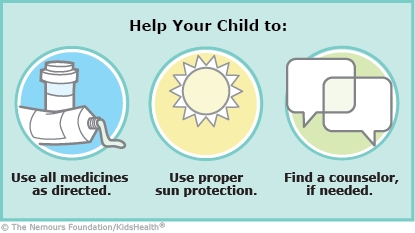Vitiligo: How to Care for Your Child
Vitiligo is a loss of skin color. It is not contagious and doesn't cause health problems.


Melanocytes are a type of skin cell that produces melanin, the pigment that gives skin its color and helps protect it from the sun. Although the cause of vitiligo is not clear, it might be that the immune system mistakenly attacks healthy melanocytes. They suddenly stop producing melanin, and light or white patches appear on the skin. These patches can burn and blister easily if your child goes outdoors without sunscreen.
Vitiligo varies from person to person. A child may have just a few spots in one area, or have many spots on one or both sides of the body. The patches may grow bigger over time. Pigment cells are also found in the hair, genital area, ears, and eyes, so sometimes vitiligo also involves these parts of the body.
Vitiligo is not contagious. It appears to run in families, and millions of people worldwide have the condition. Although vitiligo can start at any age, about half of the time it shows up before 20 years of age. It happens in people of all races, but the spots are easier to see in those with darker skin.
A dermatologist (a doctor who specializes in skin problems) usually can make the diagnosis of vitiligo by talking to you and your child and doing a physical exam. Sometimes a special light called a Wood's lamp is used to help the health care provider see the patches. A blood test may have been done to check for other conditions that are caused by problems with the immune system.
The most common treatments for vitiligo are prescription creams or light treatments (which are done in the health care provider's office). These treatments may help bring color back to the skin.

-
If your health care provider prescribed a cream, make sure your child uses it as directed.
-
Offer support and answer any questions that your child has about vitiligo so that he or she knows what's going on and isn't ashamed.
-
Being out in the sun can make the patches of vitiligo show up more and may increase your child's risk of skin cancer. Teach your child how to protect the skin from the sun:
-
Apply sunscreen with an SPF of 30 or higher every day.
-
Avoid the strongest sun of the day — between 10 a.m. and 4 p.m.
-
Wear light, protective clothing and a hat when out in the sun.
-
Do not use tanning salons.
-
Schedule any recommended follow-up appointments.

Your child:

Any condition that makes kids look different from their friends can be upsetting for them. Encourage your child to find enjoyable activities and to spend time with friends. Sometimes getting involved in a vitiligo support group or talking to a counselor can help.